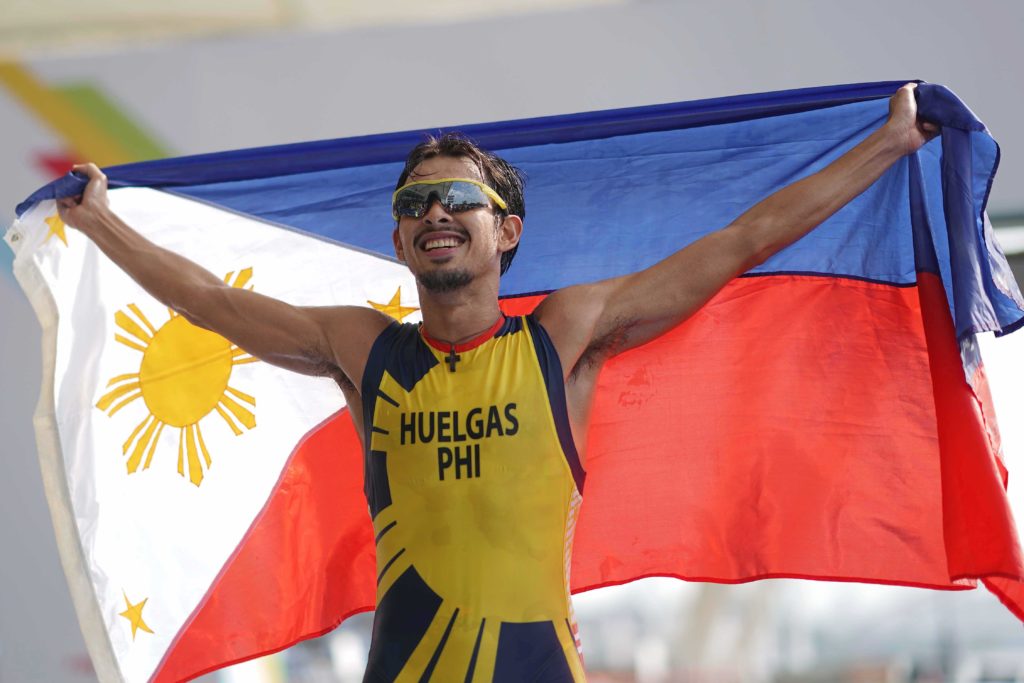Legacy cemented, Huelgas looks at bigger picture

CONTRIBUTED PHOTO/SEA GAMES POOL
Nikko Huelgas fished out his phone, tapped on an app and scrolled down to a photo he posted almost two years ago.
“I still get goosebumps looking at this,” he said. The post was a screen-grabbed Inquirer banner photo that featured Huelgas looking skyward, arms stretched sideways, after nailing his first Southeast Asian Games triathlon gold medal in 2015.
He has come a long way from that. After being the first Filipino to bag a gold medal in SEA Games triathlon, Huelgas is now the country’s first back-to-back gold medalist in the sport.
Huelgas clocked 1:59:02 to triumph anew in Kuala Lumpur, spearheading a pair of gold-silver triathlon finishes by the Philippines in the men’s and women’s fields.
“The first thing on my mind after I finished the race was finally, after everything we had done and after all those days, weeks, months and years away from your family and loved ones and all those sacrifices were worth it,” he said Thursday evening when he guested at Sports IQ, the Inquirer’s live multiplatform sports talk show.
While the gold medal produced some sort of a salve to ease the burn of a sputtering Philippine campaign in the biennial meet, it actually wasn’t Huelgas’ goal for the tournament.
The 26-year-old athlete had a bigger goal in mind: Pull the SEA Games triathlon event to world-class levels.
“Our coach, Melvin Fausto, told us not to think of the gold or silver,” he said. “The goal was to finish under two hours. Coach told us that if we won the gold and silver but failed to finish under two hours, it would not mean as much.”
The sub-two hour mark in triathlon is a world standard for Olympic distances. And winning under that mark, Huelgas said, helps erase the notion that SEA Games triathlon is a low-level competition. And by raising the profile of the sport in the region, it automatically puts the country’s triathlon program in the spotlight.
“We wanted not just to win, but to also showcase Philippine triathlon to the world. We wanted to show that the SEA Games is not just a low-level competition by finishing in a world-standard time,” he added.
And it took a lot for Huelgas to accomplish the feat.
“The preparation was still the same in terms of hard work and effort. But the approach was different. I was more calm, more mature,” Huelgas.
“[My goal] demands a reinvention of the self. If you keep doing the same things, you can’t expect to achieve something different,” he added.
While getting under two hours took a lot of physical preparation, Huelgas said the mental preparation he undertook for the SEA Games was likewise crucial.
“The mental part is more important—to train your mind to get used to the pain for a long period of time. [Because] the winner is the one who can hold on to the pain the longest.”
And for some reason, Huelgas needed to be extra tough mentally for the SEA Games. Just before the event started, he hit a puzzling funk. He was feeling tired and anxious and was experiencing a lot of self-doubt that he contemplated quitting.
“You suddenly feel and see all those things that you never did before the race and that makes you crazy,” he admitted. “It felt like I wanted to give up.”
But then he got a boost from an unexpected source. Martin Camara, a chiropractor to several athletes, visited Huelgas in Malaysia to do a physical check on his condition.
“When he said ‘Nikko, you’re good to go,’ all of a sudden, all my doubts and worries were gone. I was ready to go,” said Huelgas.
And ready to win.
The victory lines Huelgas up for a three-peat when the Philippines hosts the SEA Games in 2019. And more than that, it also gave him a sign that he is taking the right path in his athletic career.
“I feel so honored, privileged and humbled at the same time after winning a gold again for the country,” he said. “And I feel that the gold is a sign that this is just the beginning and that greater things are coming for Philippine triathlon.”
And you can trust Huelgas on that. The guy doesn’t just recall photographs posted on social media two years ago. He also knows how to look at the big picture.
